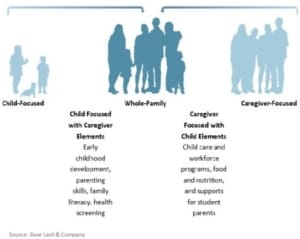A Community Call to Action to Address Our Economic and Social Gaps
In 2018, more than 30 stakeholders volunteered to create a working committee to promote Two-Generation (2Gen) policies, practices, and programs in Cuyahoga County, Ohio. 2Gen approaches offer whole-family interventions that meet the needs of children, their caregivers, and the family as a unit and operate from the understanding that adults want to help their children succeed, and want opportunities for success in their work and lives as well. This committee, comprised of parents, concerned citizens, and staff from human service, educational, and funding organizations, has been working to outline next steps to achieve those ends.
2Gen Cuyahoga
2Gen is a family-centered, highly positive service delivery mechanism that seeks to reorder traditional ways that programs serve families.
It addresses some of the common issues faced by early education, adult literacy, and workforce development programs and the clients they serve. For example, early education and student academic progress are negatively impacted if caregivers are unable to read to their children due to low literacy. Similarly, adults who are enrolled in workforce training programs face real barriers to successfully completing programs if they are unable to access affordable childcare. As a result, many of these partners have seen reduced enrollment in the last few years resulting in many slots going unfilled. They have exhausted traditional methods of recruitment. 2Gen partnerships are a way to explore additional recruitment opportunities. Through this Call to Action, we seek to outline a new standard for service delivery and program effectiveness that can successfully and efficiently challenge the complex problems of social and economic inequality that threaten the future of both our city and county.
Community Action Plan (Download)
Community change requires shared will. In Cuyahoga County, 2Gen approaches needs a strong network of community organizations that are committed to changing the landscape of economic and social inequalities. This can be achieved through the following actions:
- Involving parents and family members to be part of our planning process.
- Expanding inter-agency knowledge among all service providers (site visits and sharing).
- Implementing formal referral strategies and shared databases among all organizations providing services to children, adults, or families.
- Incubating a 2Gen programming pilot and tracking results, scalability, and sustainability.
These strategies will yield 2Gen implementation to benefit Cuyahoga County families and offer a framework for the working committee’s actions.
Many communities like Cuyahoga County have rich service delivery in each of these areas.
However, a community can be service-rich and connection poor. Such “poor connectivity” is not the fault of individual organizations or leaders. Program design, policies, accountability, and funding structures have created systems that are designed to exist separately, with little incentive to combine or network between services. We become experts in our own areas with poor knowledge of what exists in other service domains. At both the 2Gen Literacy Summit in 2018 and the working committee meetings, the call was clearly present to know more about what services are available and to understand where our service “gaps” are the greatest.
The Difference between Policies and Programs
While providing critical help to many, federal and state programs designed to help low-income families overcome their daily challenges often operate in isolation from one another. Moreover, many of these programs were not designed for interagency collaboration. This rigidity filters down to the nonprofit, faith-based, and community-based organizations working with low-income families. Different funding sources, distinct definitions of success and narrow guidelines impede these organizations’ ability to respond to the needs of children and parents/caregivers in tandem.
Our Call to Action in Cuyahoga County seeks to partner with local policymakers and funders in achieving this goal.

